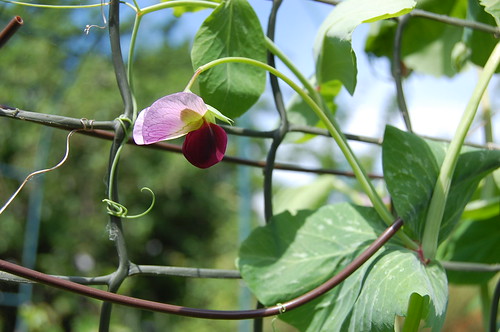
Golden Sweet x Carruthers' Purple Podded F2. First one to flower.
Today has been a perfect day for hand-pollinating peas. Warm and dry but not too sunny - which creates just the right conditions for pollen to spill its abundance and for stigmatic goo to be in the right mood to receive it. Even more usefully, it was completely breezeless with not so much as a leaf blade stirring. The bitter lessons of trying to hand-pollinate flowers that are thrashing about in the wind, not to mention walking across the garden with a precious blob of pollen on the end of a scalpel, have taught me that pollinations on breezy days are the stuff of futility. All the more so for those of us with waist-length hair, which is guaranteed to flap across your face at the very moment you were trying to deposit a miniscule dab of pollen onto a particularly wobbly and elusive stigma.
As the weather was so perfect for it, I was really hoping to get some useful pollinations done for my red podded pea project. Only trouble is, most of the flowers I want aren't ready. The true red podders aren't even producing buds yet, and my semi-red mangetout line, which I'm hoping to cross with the Luna Trick sugarsnap for some peachy-red snap pods, didn't want to play either. I found a prime pollen-bearing bud on it that was well past the usual stage for self-fertilisation but when I cut it open I found it stubbornly refusing to dehisce.
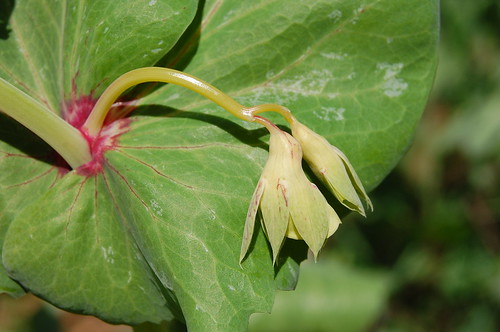
An F4 plant from my semi-red podded mangetout line, currently struggling under the temporary working name of Peachy, getting ready for some blossom action (but not yet).
So instead I did some pollinations I didn't really need using the flowers I had available. It is worth pointing out that my beloved Luna Trick pea is the result of just such a casual union, in which I used up the last of some Sugar Ann flowers to pollinate a few buds of Golden Sweet just because I was bored. It turned out to be an inspired combination. Today's efforts mostly involved Sugar Snap flowers as females, pollinated with some of my purple F2 plants which may or may not turn out to be any good. I used the opportunity to take some close-up photographs of the pollination process. It's my fourth attempt to take such pictures. Thing is, you really need three hands for it, or an assistant who knows what they're doing. I have neither, so Plan B was to stick the camera on a tripod and use the self-timer for some very cumbersome hands-free photography, which resolved the three-hands issue but gave me some more challenges in trying to get it to focus in the right place when there's negligible depth of field. Anyway, if any of them are any good I'll add them to my previous pea-breeding tutorial.
The hand pollinations are just one aspect of what I'm doing on this crimson seeking project. Since my pièce de résistance in the red podded pea department stubbornly refused to yield me any fibre-free pods, I've been looking at alternative ways of getting them. Which now involves several simultaneous endeavours.
Growing out the rest of the F2 seed from whence the original came. This is the biggest hope. The particular combination of genes I need are a minority class which will only show up in a small proportion of the F2 offspring. I need the yellow pod gene (recessive), two purple pod genes (both dominant) and two fibre-thwarting genes (both recessive). I can't be arsed to look up in a Punnett Square what the actual chances are and calculate the number of plants I need for 95% probability … I'm content to know that it may take a lot of plants in order to deliver the holy grail. This year it's down to luck anyway, as I have only a small amount of F2 seed left and so I can't grow lots of plants. Even the seed I do have is of poor quality because it was grown from a late summer crop (I used to have this trick of growing two consecutive generations in one season to double the speed of my breeding work, but have since stopped doing it because the second crop yields weak seed at best, and at worst yields nothing and just wastes valuable breeding material). So I have about fifteen, maybe twenty plants, and they may or may not offer any red pods. The moment of truth is approaching, as the F2 plants have got flower buds.

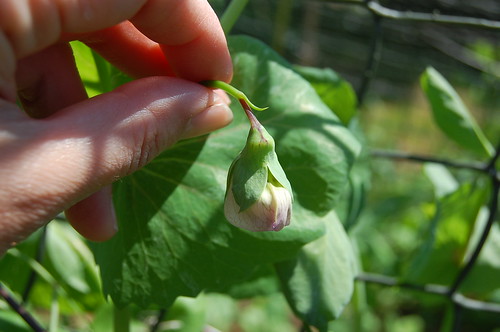
They're very pretty buds, with the mauve blush that promises bicolour flowers. Both parent varieties had bicolour flowers, so I'm expecting to see it in all the offspring. The ones shown above are fairly typical and there are others similar, with more or less purple sploshing on the stems and leaves. But I can already categorically rule out any red pods from these two plants or any of the others currently budding. The reason? Green calyx.
Green calyx means green pods. I've noticed from my work with yellow podded peas that there is a direct correlation between the calyx colour and the pod colour. Yellow podded peas are always preceded by pale cream buds which turn into a cream calyx. Sometimes it has green mottling, and pink dapples, but the base colour is always cream. (Have a look at the picture of Peachy above and see how cream the calyx is compared to these F2 buds). I suspect the cream calyx/yellow pod may actually be coded by the same gene. If they are separate genes, they are certainly slapped together pretty tightly on the chromosome, and inherit together. It's not affected by flower colour - you can get white flowers or purple bicolour flowers on a yellow-podded pea, it's just the calyx and pod colour that are inseparable from each other.
When I say that green calyx means green pods, it may also mean purple pods … or partial purple. That's because purple podded peas are in fact green podded. I know that sounds weird, and I've had to explain it so many times on plant breeding forums it's obviously something a lot of people find hard to follow. If you look closely at a purple pod, the very tip where it attaches onto the plant is green. Break it open and it will be green inside. The purple pigment, no matter how intense it looks, is merely on the surface, and the base colour of the pod is green. This is also the reason why all purple podded peas turn green when cooked. The water-soluble anthocyanin pigment is just sitting on the surface and is washed away in hot water.
I admit it did take me a while to work this out. The first time I grew F2 seeds from this cross, it produced red, green, yellow and purple pods in varying proportions. I couldn't understand why a cross between a purple podder and a yellow podder yielded so many offspring with green pods. Neither of the parents appeared to have green pods so where did they come from? The simple answer is that the purple parent is green podded, with the green hidden under the layer of purple. In the great gene reshuffle, some of the offspring end up with green pods without the genes for purple overlay, and so they stay green.
The same principle applies to red pods. They are simply yellow-podded peas with a purple overlay, which combines visually to make deep red. It's not possible to have red pods unless the base colour of the pod is yellow. That's how I know the two buds shown above are not going to give me red pods. A red-podder bud will invariably have a cream calyx, not a green one.
While I shouldn't condone the practice of peeking inside unopened leaf clusters to look at bud colours, I naturally can't resist it. And it's been very encouraging. Because two of the upcoming F2 plants which are not ready to blossom yet are showing cream buds among distinctly yellowy foliage. Even when they're tiny, the cream colour is unmistakable. The cream buds don't necessarily result in red pods, some will just stay yellow, it depends whether the genes for purple overlay are also present. But they do open up the likelihood of it. Also, one of the cream buds is showing a speck of pink colour on the calyx. While I don't have a genetic explanation for it, I have noticed a strong correlation between pink markings on the calyx and red pods. So I'm feeling lucky with this one.
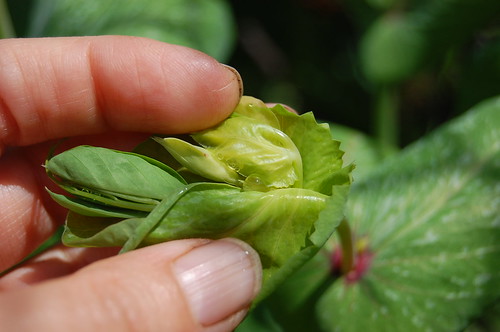
Maybe it's not very clear in this photo, but this developing bud has a cream calyx - ergo yellow pods. Also a tiny pink spot on the calyx which is a good sign.
It's still pot luck whether any of the plants in this small sample will give me exactly what I want, but the solution is in there if only I can grow enough F2 plants. Which brings me on to my convenient back-up plan …
Growing out more F1 plants to make new F2 seed. I still have a number of F1 seeds saved from when I made the original cross. The seeds are good, healthy mature ones too. I started off a batch of about ten F1 plants this year. The beauty of peas and their efficient self-pollination is that you don't need to do anything except grow the F1 plants and save seed from them. They are veritable F2 seed machines. Every pea they produce has a unique individual genome, its own personal reshuffling of all those genetic goodies. Somewhere among the reshuffles is bound to be the specific five-gene combination I'm looking for.

F1 hybrid of Golden Sweet x Carruthers' Purple Podded. Flowering like billy-o and hopefully making lots of nice F2 seeds for me.
What's interesting about these F1 plants is that they are showing massive hybrid vigour, or heterosis. It's a phenomenon brought about by having a mixed up genome, a by-product of heterozygosity. Its cause has always been something of a mystery, though I'm told that some recent research has put it down to an enhanced ability for photosynthesis. Whatever the reason for it, my own observation is that it only happens in certain crosses - though there are degrees of it. And it's for one generation only - you don't tend to see it in F2 plants. This has been especially marked in my current crop, because I sowed the F1 and F2 seeds from the same cross side by side in the same rootrainer tray, and they are now growing side by side out in the garden. And from the moment of germination, the F1 plants rocketed away from their F2 nephews. They grew faster, had thicker stems, established themselves in the outdoors quicker, produced substantially bigger leaves and grew taller. They were also earlier to flower - and still having a burst of surplus energy to get shot of, have thrown out a lot of sideshoots too. Pea sideshoots are usually feeble, spindly things, if they ever get going at all. These are nothing of the sort. They are full-size, chunky, vigorous new branches which look set to flower and make pods.
Something else peculiar about the F1 plants, or one of them at least. I've been writing about the leaf aberrations in my peas this year, which I'm beginning to conclude are probably weather related. I mentioned the fasciation (thickening of the stem) in one of my other hybrids, despite the fact that it's a trait caused by recessive genes. Well, now some spontaneous fasciation has occurred in one of these F1 plants. To my knowledge, there are no fasciation genes in this hybrid, which is not related to the other one - they are completely separate breeding lines. Which leads me to assume that pea fasciation is not solely genetic, and can arise as an environmental reaction. What's even more weird is that the plant in question managed to unfasciate itself by splitting into two stems. A single stem with a well developed sideshoot is one thing, but this is a pair of twin stems growing at the same rate in different directions, equal and opposite.
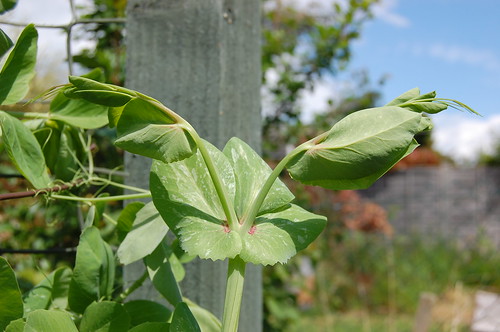
This F1 pea developed spontaneous fasciation (stem widening) and then split into two separate but equal growing tips. This is not normal for peas!
Edit: I've just done some homework on fasciation, following a link from Rhizowen's wonderful blog, and it seems that spontaneous fasciation from environmental stress is a well known phenomenon - actually more common than genetic fasciation. It's caused by damage to the growing tip by virus, bacteria, insect nibbling or frost - and a reversion back to normal growth is also common. In this case, frost is almost certainly the culprit.
Other avenues. I had just eight seeds left from my original red podded pea. I sowed them, and three fell victim to marauding gastropods. The five survivors are doing well though, and although there will be no edible pods among them, they will enable me to make some crosses. The priority will be to cross them with my two Luna Trick lines, which are genetically similar, being derived from the same original parent variety, but represent a superior form of it with good-flavoured and fully edible yellow pods. Another batch of twenty or so are on the go, thanks to my big haired friend Graham, who grew some last year and gave me back some seeds from the best of them. Again, they won't have edible pods, but they will be priceless for making crosses and might also make the basis for a red-podded shelling pea. Also of course there's the Peachy line which has edible pods which are part-red. That might turn into a variety in its own right, and will certainly be useful for making crosses with the pure red (if it ever gives me any pollen).
12 comments:
Just awesome, I am so intrigued, a good read.
The Gardener
I haven't (yet) seen spontaneous fasciation in peas, but I've seen it in a dandelion on my plot which turned cristate one year, then went back to normality. I suspect there are probably several causes for it; it's certainly not all genetic.
Just want to let you know i am petitioning the universe on your behalf. Entirely self-serving of course since i want to be able to grow some red podded peas of my own one day ; ) Go Rebsie!
Love your posts! I have been meaning to try the same cross as you did to get your red peas but just had not had time yet. I was able to cross a couple other peas though (I think Margaret McKee's Baking Pea x Sparkle). Not sure what I could get from this cross but it was fun. I need to find my list of what I planted where so I can try some more. I don't think the peas will last too much longer here though as hot weather will be here soon. Thanks for your instructions!
Good luck with the search. You might start these lines with an aim in view but you really never know what you're going to get, do you? This cross has thrown up some really intriguing possibilities. Keep us posted.
What an incredible blossom. I am not at all familiar with this plant, but it sounds like one I would like to get to know better.
Hi Rebsie
Thanks for the kind comment and link. Your blog is brilliant and really ought to be turned into a planty version of Bridget Jones' Diary - a guaranteed best seller, containing as it does the themes of love, loss, sex (of the plant variety) and triumph over adversity. Chapter 15, The Arse of Doom - who could resist that?
Owen, thank you - the blog admiration is entirely mutual. Radix is a real favourite of mine, not least because you're such a clever and funny writer.
Rebsie, Sorry this comment is so late, but it brings good news. I have been doing a little bit of pea breeding, and have been researching pod colour genes. It seems that there are two different sets, on different chromosomes (so they are inherited independently). Also, the genes for 'mangetout' (thin pod walls) is on a separate one again. From what I have read, edible pods should be dominant over inedible (although isn't always the case in my hybrids..?).
So, green pod is dominant over yellow pod, and purple is dominant over non-purple (as your hybrids show). My guess is that the red is from purple overlaid on yellow pods. When it is overlaid on green, you get the purple-brownish colour (if that makes sense!)
So, the good news is that if you can cross your red non-edible pea (if you have any left- if not, recreate it with purple x yellow) with the yellow mangetout, the cross will be a mix of yellows and reds. These should be edible, but if not, one more back-cross of the reds into the yellow mangetout should do the trick!
Have been reading your fab blog for several years, keep up the great work :) Kathy in Australia
Extremely decent blog and articles. I am really extremely glad to visit your blog. Presently I am discovered which I really need. We are extremely thankful for your blog entry.
Coaching Centres in Rohini | Chemistry Coaching in Rohini | Economics Classes in Rohini | Accounts Tuition in Rohini
Great sshare
This content is very unique. Thanks for sharing your thoughts with us. I definitely will share this blog. The post gives me confidence. Such an awesome article. Now it's time to avail https://tcnaturals.ca/ for more information.
Post a Comment